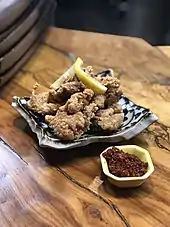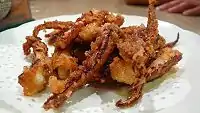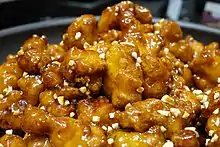Karaage
Karaage (唐揚げ, 空揚げ, or から揚げ, [kaɾa aɡe]) is a Japanese cooking technique in which various foods—most often chicken, but also other meat and fish—are deep fried in oil. The process involves lightly coating small pieces of the meat or fish with flour, or potato or corn starch, and frying in a light oil. The foods are marinated prior to coating. The process differs from the preparation of tempura, which is not marinated and uses a batter for coating.[1] Karaage is often served alone or with rice and shredded cabbage. It has become popular to eat Karaage wrapped with green perilla leaves and lettuce leaves.

Origin
Karaage is often cited to have been popularized in the 1920s by the Toyoken restaurant in Beppu, Japan. The method was popularized because of the food shortages in Japan after World War II, specifically for chicken. Chicken was already a popular meal, but using the Karaage method made it easier to cook, and provided a different way to eat chicken.
The roots of the style of cooking can also be found in Chinese cooking, it is very similar to how Chinese fry tofu for vegetarian dishes. The method of frying, however, has been around since tempura in the Edo period of Japan. Chinese use soy sauce and rice wine, a similar process to karaage. [2]
Since the 1920s, the dish has spread widely throughout all of Japan. Karaage is mostly in reference to fried chicken, as the fried chicken has become the most widespread version of the cooking style. Karaage—the chicken version—is commonly available in convenience stores such as Lawson, FamilyMart, and 7-Eleven as a fast food item. It is also readily available in food stands throughout Japan.[3]
When coated with starch, it is called Tatsuta-age. Tatsuta is the name of a river, but there are conflicting theories as to why it was called that.
Karaage is also widely available in festivals and food stalls throughout Japan. One such festival is the Oita annual Karaage Festival, where over 60 different shops participate to provide unique versions of the Japanese delicacy.[4]
.jpg.webp) Chicken karaage at Gyoza no Ohsho
Chicken karaage at Gyoza no Ohsho Gobō karaage
Gobō karaage Octopus karaage
Octopus karaage Squid tentacle karaage
Squid tentacle karaage Perch karaage
Perch karaage
Karaage in the media
Karaage has been embedded into Japanese cuisine and has made several TV appearances. Probably the most notable appearance has been in the anime/manga series Shokugeki no Souma, a show about a young aspiring chef who sticks to his roots in family restaurant food.[5]
Another notable mention was Anthony Bourdain. Bourdain sang praises for the Japanese fried dish in an interview, saying that he always stopped by Lawsons to pick up karaage when he visited Japan.[6]
Regional Karaage
Since Karaage has spread throughout Japan, there have been many regional takes on the dish. Here are the most notable ones:[7]
- Zangi- Hokkaido prefecture's version of karaage, made with a marinade and served with a spicy dipping sauce.
- Tebasaki- Nagoya’s version of karaage, made with bone in chicken wings, sprinkled with sesame seeds and basted with a special sauce.

- Toriten- Oita prefecture’s version of karaage, coated in wheat flour and often used as a topping for udon noodles.
- Chicken nanban- Miyazaki prefecture’s version of karaage, dipped in sweet vinegar and topped with tartar sauce.
- Gurukun no kara-age- Okinawa prefecture’s version of karaage. Gurukun is Okinawa’s official and most popular fish, often called a “banana fish”, it is a fish fried whole and served with lemon.
- Dakgangjeong[8]- Korea's take on fried chicken, very similar to Karaage, but usually made with milk and a sort of sweet/spicy sauce consisting of soy sauce, rice wine, red chili pepper paste, honey, and seasonings.
References
- Judkis, Maura (26 November 2014). "Plate Lab: Karaage is like Japanese fried chicken". Washington Post.
- "Japan's History of Fried Food". TalentHub Blog | Live and work in Japan. 2017-10-24. Retrieved 2019-05-31.
- Nomura, Mona (2017-02-21). "Japanese Convenience Stores Are Havens Of 24/7 Snacking". Eater. Retrieved 2019-05-31.
- "Toriten & Karaage Chicken | Oita, Japan | Tourism Information". www.discover-oita.com. Retrieved 2019-05-31.
- MKD TUBE 2.0 (2019-01-13), 食戟のソーマ Shokugeki no Soma [HD] WALK-N-EAT-KARAAGE || Best moments #6, retrieved 2019-05-31
- Joyce, Tabitha. "Anthony Bourdain's favourite foodie finds". CN Traveller. Retrieved 2019-05-31.
- "Chickened Out: Kara-age, Tatsuta-age, and More - Special Features - Japanese Food". NHK WORLD. Retrieved 2019-05-31.
- "Dakgangjeong (Sweet Crispy Korean Fried Chicken)". Korean Bapsang. 2014-03-17. Retrieved 2019-05-31.
External links
| Wikimedia Commons has media related to Karaage. |
- Japan Karaage Association (in Japanese)
- Karaage JP (in Japanese)
- Photos and further info about karaage (in English)
- Chicken Karaage recipe video (in English)
.jpg.webp)